A two-stroke engine or a two-cycle engine is a popular engine found in small machines like chainsaws and lawnmowers. It is a more powerful engine producing power after every two strokes.
And because of this, two-stroke engine works on oil gasoline mixture as we have no separate chamber like in four-stroke engines. Hence, it is super important to know and use the right oil mix for a smooth operation.
Too much oil in the oil mix can cause your engine to stall, generate carbon build-up or produce excessive smoke thus affecting the performance of your equipment. While too little oil can result in overheating and internal damage to your engine.
It is either recommended to use a 25:1 or 50:1 oil mix for all equipment having two-stroke engines. 50:1 means for every 50 parts of fuel, there is 1 part of the oil, and 25:1 means for every 25 parts of fuel, there is 1 part of the oil.
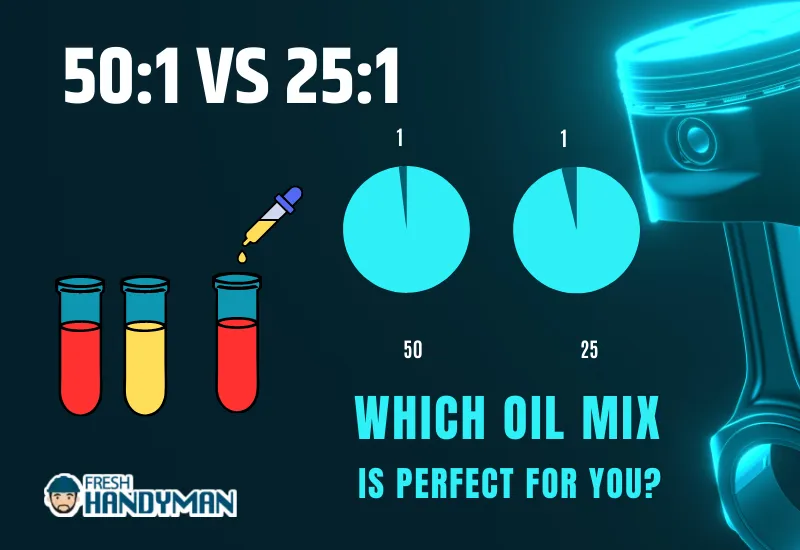
If you want to avoid permanent wear to your engine and spark plug, it is important to use the recommended oil mix for optimal engine performance and longevity.
Let’s discuss in detail, 25:1 or 50:1? which oil mix is suitable for your equipment.
50 to 1 Vs 25 to 1 Oil Mix [Comparison Table]
| Key Factor | 50:1 | 25:1 |
|---|---|---|
| Oil Density | Lower | Higher |
| Lubrication | Less | More |
| Engine | 2 Stroke | 2 Stroke |
| Viscosity | Less | More |
| Price | CHECK LATEST PRICE | CHECK LATEST PRICE |
Understanding Two-Stroke Engine Oil Ratios

A two-stroke engine doesn’t have a dedicated lubrication system like a four-stroke engine and therefore, it derives lubrication directly from the oil mixed with gasoline. The lubricant oil mixed with fuel helps in reducing the cylinder and piston area.
Now how would you know the optimum two-stroke oil ratios suitable for your two-stroke engine? The simplest answer to this query is the specific oil ratio required is available in the equipment manual. Identify the oil ratios and follow the recommended steps.
Here are some of the common oil mix ratios used in two-stroke engines:
| Oil mix ratio | Ounces of oil per gallon Gas |
|---|---|
| 20:1 | 6.4 oz. |
| 25:1 | 5.2 oz. |
| 30:1 | 4.3 oz. |
| 32:1 | 4.0 oz. |
| 40:1 | 3.2 oz. |
| 50:1 | 2.6 oz. |
| 60:1 | 2.1 oz. |
| 80:1 | 1.6 oz. |
| 100:1 | 1.3 oz. |
What Does 50:1 Means?
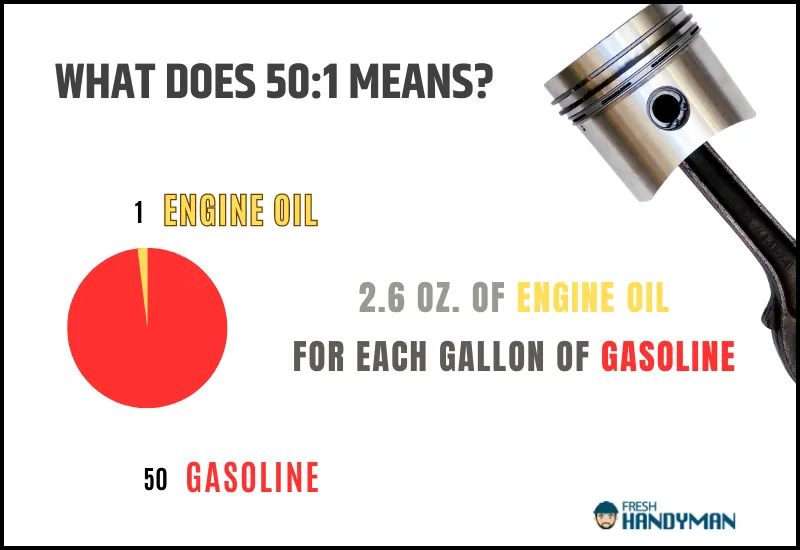
A 50:1 oil mix means for every 50 gas parts, mix 1 part of engine oil.
To get this ratio, you need to add 2.6 ounces of oil for each gallon of gasoline. This means 12.8 ounces of oil is needed for 5 gallons of gasoline. Like me, always use a calculator to get the accurate oil mix ratio.
If you are not confident about the calculations or want to just avoid this hassle, buy premixed gas products. Another notable thing I recommend you consider is using non-ethanol gasoline to prevent any damage to your engine.
See Also: Can You Use 50 To 1 In 40 To 1? [Detailed Explanation]
Advantages and Disadvantages of using 50:1

Some major advantages that you will get while using a 50:1 oil mix for your two-stroke engine include:
- 50:1 oil mix gives you better lubrication to your engine compared to any other oil mix ratio, particularly the lower oil mix ratio.
- This oil mix produces lesser harmful emissions by burning cleaner compared to lower oil mix ratios.
- 50:1 oil mix helps you in providing better acceleration, upgraded engine performance, and seamless operation.
50:1 is an ideal ratio for many small equipment operating two-stroke engines but it also has some drawbacks:
- The high-quality oil used in 50:1 is more expensive than the oil used for other lower-oil mixes.
- If the oil mix ratio is quite lean having too little oil in the mixture, it can result in overheating and pertinent damage to the engine.
- 50:1 oil mix is not recommended to use in all two-stroke engines. So, always read the recommended oil mix ratio mentioned in the manufacturer’s manual.
Types of engines requiring 50:1
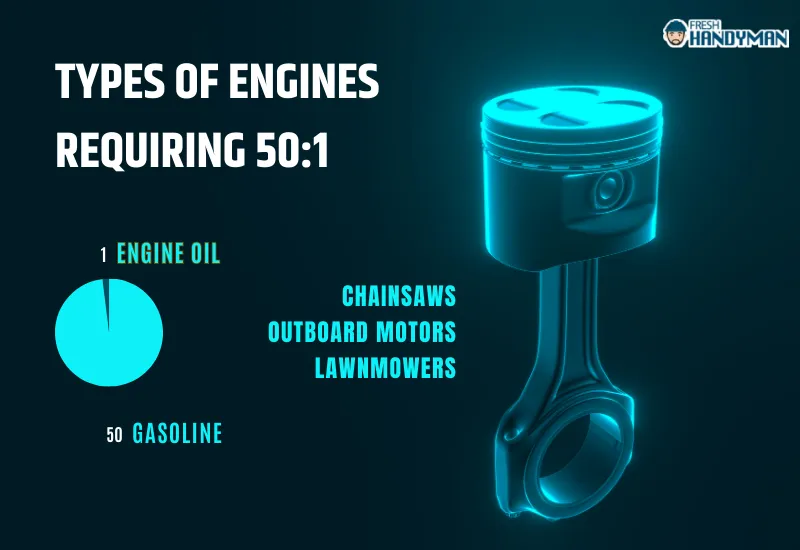
As you already know many two-stroke engines require 50:1 for the ideal performance but it is not the case in all. Engines are designed to run on a particular oil mix ratio, which is mentioned in the manufacturer’s manual.
Many tools such as chainsaws, outboard motors, and some lawnmowers require a 50:1 oil mix for their two-stroke engine.
What Does 25:1 Mean?
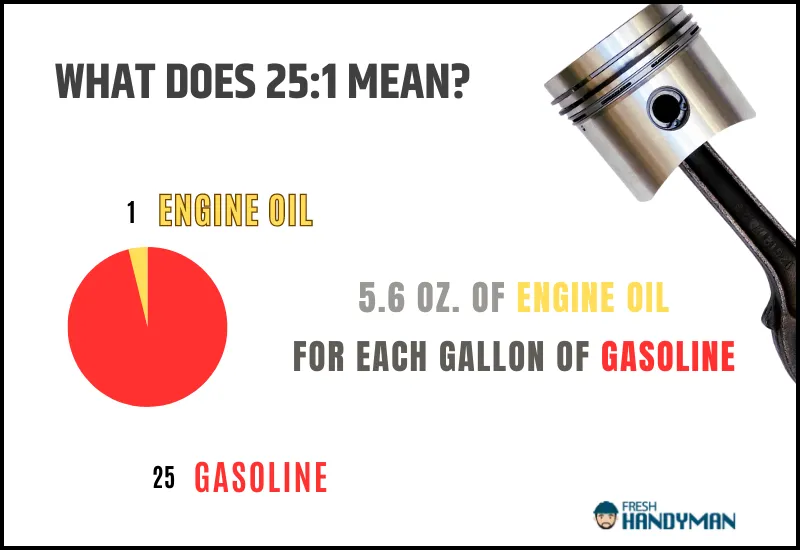
A 25:1 oil mix means for every 25 gas parts, mix 1 part of engine oil.
To get this oil mix, you require 5.6 ounces of oil for each gallon of gasoline. This means 26 ounces of oil is needed for 5 gallons of gasoline. After measuring the exact volume, now pour it into the fuel tank of the equipment.
Advantages and Disadvantages of Using 25:1

Using 25:1 gives you numerous advantages such as:
- As 25:1 is more dense than the 50:1 oil mix, it provides additional lubrication to the engine which is good to increase its lifespan.
- 25:1 is an ideal choice for older engines as well as high-performance two-stroke engines.
- More oil in the mixture keeps the temperature of the engine moderate by dissipating heat more effectively and efficiently.
However, there are some drawbacks to using 25:1 for your engine that includes:
- The use of a higher quantity of oil in the mixture can damage the spark plug resulting in engine issues and starting problems.
- Increasing the amount of oil can result in more emissions, thus increasing air pollution.
Types of Engines Requiring 25:1
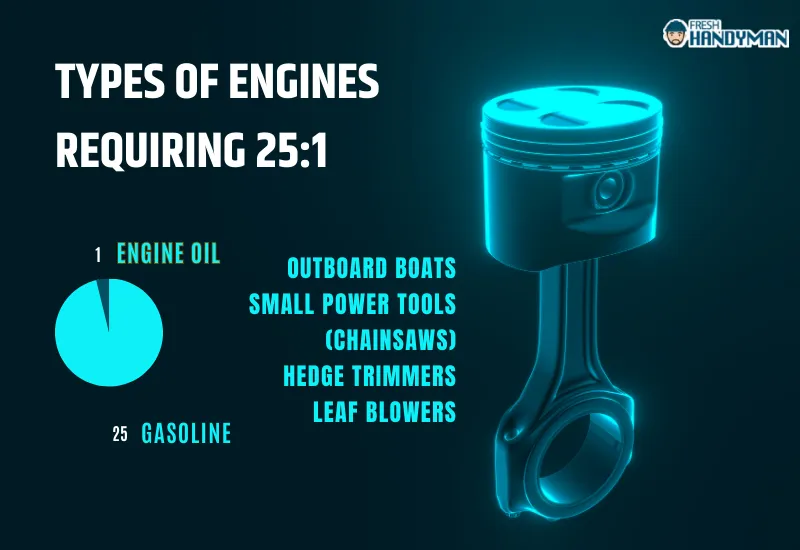
25:1 oil mix is not ideal for newer and all types of two-stroke engines, but you can use it in other equipment.
It is used specifically in older equipment like older outboard boats, small power tools (chainsaws), hedge trimmers, and leaf blowers.
The Main Differences Between 50:1 and 25:1
Both 50:1 and 25:1 is used widely in two-stroke powered equipment, but you might want to know what is the difference between them.
Key Differences:
- Oil ratio: The primary and most prominent difference between 50:1 and 25:1 is the ratio of oil. 25:1 oil mix contains more oil ratio compared to 50:1. This means 25 units of gas per oil drop for 25:1 and 50 units of gas per oil drop for 50:1.
- Lubrication: The more oil ratio in 25:1 makes it more lubricant than 50:1 having less oil content. This gives an advantage to the engines operating at higher temperatures.
- Viscosity: 50:1 is less viscous and flows fast which makes it a perfect match for the 2-stroke engine. While if you want more flow resistance, 25:1 is ideal for your chainsaw, as older chainsaw requires more lubrication.
- Emissions: 25:1 oil mix produces more harmful emissions compared to 50:1 contributing to air pollution.
Which Ratio is Better Suited for Different Types of Engines and Conditions?

In my experience, A 50:1 oil mix is better suited for newer engines designed to work on this ratio. Other than this engines with normal to mild operating conditions require 50:1 as lower oil content prevents fouling of spark plug and thus increasing the performance.
While 25:1 is better suited for the engines that are already being used or high-performance engines with high compression ratio. The additional oil proportion in the mixture can help reduce damage to the engine components.
Benefits of Using 50:1 Oil Ratio
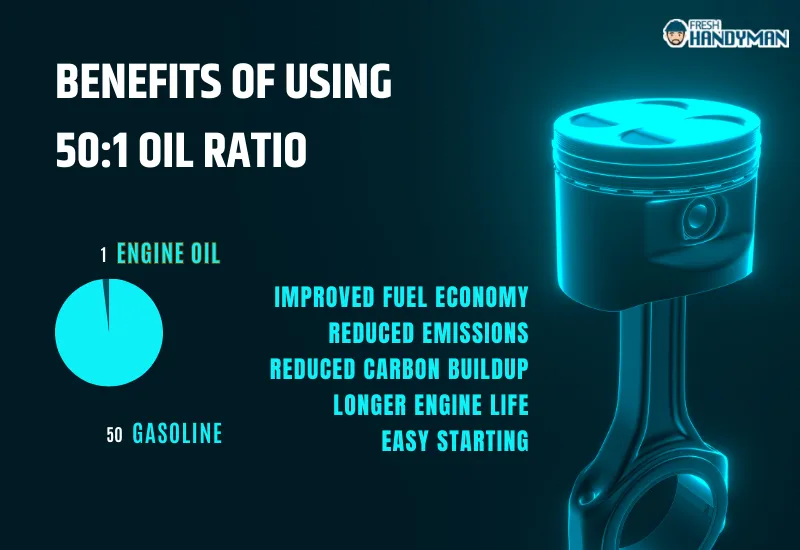
There are several benefits of using a 50:1 oil mix which include:
- Improved fuel economy: 50:1 oil mix requires lesser oil content which is helpful to run the engine for longer periods increasing the fuel economy.
- Reduced emissions: Low oil content means lesser unburned hydrocarbons which are eco-friendly.
- Reduced carbon buildup: 50:1 burns more cleanly thus reducing the amount of carbon buildup on the internal components of the engine.
- Longer engine life: Some two-stroke engines are designed to run on 50:1. By using the correct oil mixture results in longer engine life.
- Easy starting: Low oil proportion prevents the damage to spark plug thus helping it to ignite and start the engine more easily.
Read this: Chainsaw Won’t Start Has Spark And Fuel:3 Tested Ways to Fix
Benefits of Using 25:1 Oil Ratio

Some of the major benefits you get by using a 25:1 oil mix include:
- Better lubrication: Having more oil content results in producing more lubrication. This will prevent any wear and tear of the engine’s components thus prolonging its lifespan.
- Enhanced engine performance and acceleration: 25:1 offers better lubrication which results in the smooth running of the engine thus enhancing its performance, power output, and acceleration.
- Reduced risk of engine seizure: Using 25:1 result in reduced risk of engine seizure by enhancing the cooling effect, providing protection against wear and tear, and reducing friction in the two-stroke engine.
- Ideal for high-performance engines: 25:1 is ideal for high-performance engines with a high temperature and compression ratio. The higher oil content reduces the risk of damage to the engine in such harsh conditions.
How to Choose the Right Oil Ratio for Your Engine

I am pretty sure, by now you have completely understood the importance of the correct oil ratio for your engine. It is the main bloodline for your engine and your chainsaw.
Choosing an ideal oil mix for a two-stroke engine depends on various factors:
- Engine design
- Age of the engine
- Operating conditions
- And manufacturer’s recommendation.
All these factors will determine whether you are going to use 50:1 or 25:1 for your engine.
Tips for Determining the Appropriate Ratio

While determining the appropriate oil mix ratio:
- Make sure to read and follow the manufacturer’s recommendation in the manual of your equipment.
- Before going for the ratio selection, check the condition as well as the age of your engine.
- Whether it is a 50:1 or 25:1 oil mix, always remember and purchase high-quality fuel.
- Very carefully measure and calculate the exact oil-to-gas mixture and if you are doubtful, use the oil calculator to do this job.
- Mix the oil very accurately and thoroughly in the fuel tank of your engine.
Related article: Husqvarna Chainsaw Fuel Mix: (Ratio, Tips and Benefits)
Common Mistakes to Avoid
Some of the most common mistakes and blunders you need to avoid include:
- Ignoring the manual’s recommendation.
- Using the wrong type of oil in an engine designed for another type of oil.
- Mixing more fuel than the required amount.
- Wrong measurement of fuel.
- Ignoring the operating condition of the engine.
FAQs
What happens if I use the wrong oil ratio?
Using the wrong oil in your engine results in wear and tear of the engine’s components, reduction of engine performance and lubrication, and produce more smoke and carbon buildup.
Can I use 50:1 oil in a 25:1 engine, or vice versa?
Using a different oil mix ratio for the same engine depends upon the way that engine is designed. If it is designed to handle different oil mixes, you can use 50:1 or 25:1. Read the owner’s manual to get accurate information.
Is it okay to use synthetic oil in a two-stroke engine?
Yes, it is fine to use synthetic oil in your two-stroke engine. The only requirement is the oil is approved and formulated to be used in a two-stroke engine.
How often should I change my two-stroke engine oil?
You can check if the engine oil of your equipment has become thick, stale, or black, change it as soon as possible. Roughly, between 50-100 hours of operation.
Final Verdict | Recommendation
Two-stroke engines use an oil mix ratio to provide lubrication as a proper lubrication system is absent here. Therefore, a correct oil mixture is required for ideal engine performance.
You can use different kinds of oil mixtures either 25:1 or 50:1 in your two-stroke engine. 50:1 is ideal for newer engines and engines operating under mild conditions while 25:1 is perfect for older and high-performance engines.
Before selecting the suitable type of oil mix for your chainsaw, make sure to consider important factors like engine design, age, and condition of your engine.
Choose the best-suited oil mix to prevent your engine to go out of order, thus enhancing the engine’s shelf life.
Regularly check the oil quality and quantity in the oil tank and change the engine oil when required.